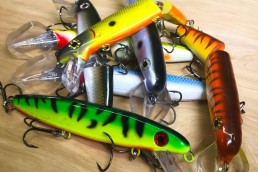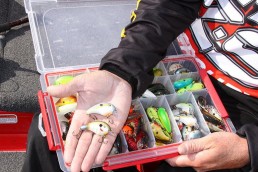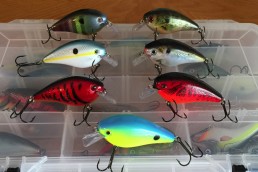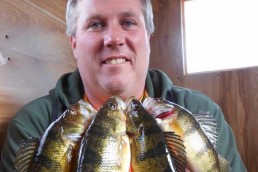How Important is Lure Color?
SHARE THIS POST
Is lure color pattern really that important?
It has often been said that manufacturers make a boatload of various color patterns to catch fishermen more than fish. Yet, pro anglers from nearly every genre, including guides and tournament participants, swear that color does indeed make a major difference, more often than not, on any given outing. I am in this same camp of believers, yet my first priority is always focused on finding fish. Once I have a target fish’s location and dialed in, then I shift over to the game of presentation. Even then, color is admittedly a notch or two down the list. It does little good to fish with the right color, yet on the wrong lure. Let me sight some simple logic in order to illustrate exactly where color legitimately should fall into your priorities.
Hypothetically, let’s assume you have located a school of walleyes that seem to be holding in the 7- to 9-foot range on a mid lake rock reef structure, and they are feeding heavily on perch minnows. You have definitely determined the exact food source, since several regurgitated perch minnows are floating around in your livewell along with the pair of walleyes you just caught.
Obviously, snapping on a perch pattern crankbait now seems like a no brainer. Digging through your tackle box reveals a near perfect 3-inch minnow bait in a perfectly replicated natural yellow perch scheme. As good as this lure looks, it simply has to catch ‘em in this situation. Yet, a dozen casts over the hotspot yields zero results. Confidence fades quickly, and in no time the perch lure is retired, and you’re back throwing a small jig with live bait. So, why didn’t this lure work? It perfectly imitated the natural forage.
Simply put, the lure probably traveled too high over those walleyes clinging tight to those 7- to 9-foot rocks. That beautiful perch replica certainly matched-the-hatch perfectly, in size and color, but it did not get down where the walleyes were. As perfect as that color scheme matched those puked up minnows in the livewell, it wasn’t presented close enough to the target in order to draw a response. So it had no chance of success. Conversely, even though the jig with live bait didn’t replicate the exact forage, it was traveling perfectly right through the strike zone. This is a scenario many walleye anglers experience on any given outing.
Are you enjoying this post?
You can be among the first to get the latest info on where to go, what to use and how to use it!
The simple answer, of course, is not only to match-the-hatch, but also to make sure that lure is actually getting in to the strike zone. The basic fundamentals of this concept and the example I just described perfectly illustrates why color should never be your primary goal. You must first determine where the fish are, and then choose the a lure presentation that gets to that zone. Then and only then does color choice matter.
From this point on, let’s assume you have your target fish’s location nailed down, and you have had some success with a few different lures in this spot. Now is the time to test various colors on them in order to see if they respond better to one over the other. Admittedly, this is where the fun begins. Not surprisingly, ardent ice anglers who chase panfish and walleyes are perhaps most well versed at this part of the game. They are sitting over a hole and can see the fish on their sonar screen below them. Location is precisely pinned down. At this point, it is fairly easy to drop various colors as well as sizes down to the fish and test their responses. More often than not, a noticeable color preference emerges in short order.
One can do the same thing with any species during any season. The key is in first knowing where the fish are and at what depth they are located. I play this color test with bass, walleyes, pike and muskies no matter when and where I fish ‘em. Once I determine where they are and at what depth they are holding at, I will test ‘em with different colors as well as sizes. Incidentally, the size or profile of the lure is often even more vital than the color choice. In many cases, the fish are sure to respond best to a specific size even more than the color. Once you have both dialed-in, you should be setting the hook constantly.
No doubt, having a solid knowledge of how deep your lures travel and how to best present these lures on any given spot cannot be overstated. Nearly every lure hanging on the shelf at a tackle store is capable of producing results when used properly. The key is in discovering each lure’s potential, and not trying to make it do what it is not capable of. I was taught long ago that all lures are essentially tools. When one chooses the right tool for the job at hand, results are attained. Results in the fishing world are hooksets, rod bends, photos and even a few tasty fish fries. Are some colors on a productive lure better than others? Locate the fish first. Find a lure that gets to where they are at and triggers strikes. Then test out various colors, and you’ll have your answer.
MWO
SHARE THIS POST
Did you enjoy this post?
You can be among the first to get the latest info on where to go, what to use and how to use it!
Joe Bucher
Joe Bucher is a Freshwater Fishing Hall of Fame Legendary Angler, book author, lure designer and host of Fishing with Joe Bucher TV series.



